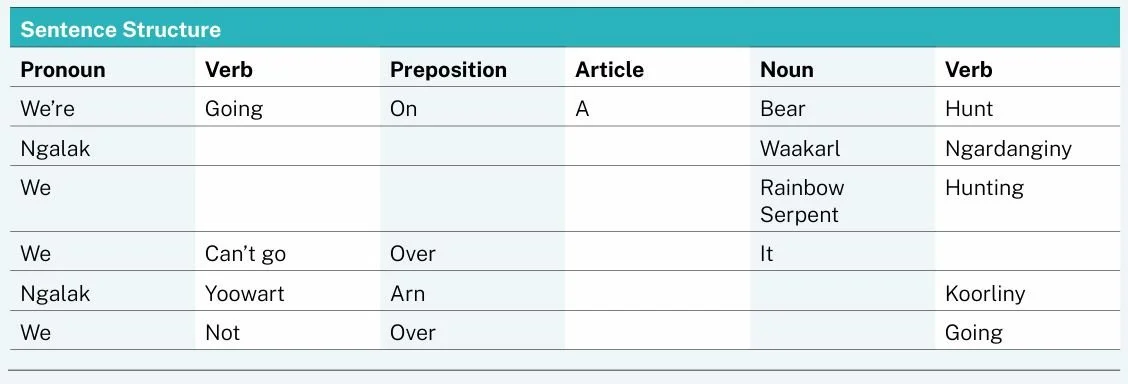Creating Noongar Story Books
Learning Area:
English
Relevant Content Descriptions:
Year 7: AC9E7LA07 AC9E7LE01 AC9E7LE04 AC9E7LE05
Year 8: AC9E8LE01 AC9E8LY06 AC9E8LY07
Year 9: AC9E9LA07 AC9E9LE01
Learning Outcome:
Use adjectives and verbs to describe plants and animals observed on country.
Task Outline for Assessment in English
Your task is to work collaboratively to produce an illustrated storybook in Noongar and English language. You will then present the book to the Grade (?) class at school.
You will need to demonstrate:
• Effective communication and collaboration with your group.
• Completion of planning stages: plot chart, storyboard, draft, and editing.
• Responding to feedback and editing your work.
• Participation in the production phase of the book as an illustrator, writer, translator and/or digital producer.
• Presentation skills when showcasing your work to younger students.
Resources
• Charmaine Bennell (2013) Ngalak Waakarl Ngardanginy: This is a re-telling of ‘We’re going on a bear hunt’ in Noongar language, and features a young boy hunting for the Waakarl (rainbow serpent).
• Kim Scott, Lomas Roberts and the Wirlomin Noongar Language and Stories Project (2011) Series of Noongar Stories
• Isobel Bevis (2024) Nedingar Ancestors, bilingual story read aloud by the author at:
https://fremantlepress.com.au/2023/06/23/video-isobel bevis-reads-nedginar-ancestors-in-noongar/
• Templates for plot mapping and storyboards (TOOLBOX)
• Noongar Dictionary e.g. Rose Whitehurst’s, available at:
https://www.noongarculture.org.au/ wpcontent/uploads/2013/07/Noongar-Dictionary Second-Edition.pdf
• The Noongar Learner’s Guide provides comprehensive grammatical constructions:
http://noongarboodjar.com.au/wp-content/uploads/2017/10/Noongar-Learners-Guide-2edn web.pdf
• This Activity Pack provides more simplified grammatical constructions:
https://noongarboodjar.com.au/wp-content/uploads/2017/10/Bird-Activity pack.pdf
Learning Sequence:
1. Discuss with the class that they will be working on a language revitalisation project, where they will write an illustrate a story to help younger students learn Noongar Language.
2. Introduce the book Ngalak Waakarl Ngardanginy, and have a Noongar speaker guide students through reading, or listen to the audio recording provided in the text.
3. Use the Translation page (you may like to make photocopies) to study the grammatical structure of the Noongar translation. See example below.
4. Working in groups, generate ideas for a storybooks. It may be helpful to conduct this stage in the school library, or to have a few books available for students to look at. They may like to choose an existing story to translate, or to create one of their own.
5. Use the plot charts (TOOLBOX) to form story idea into a basic plot structure.
6. Use the storyboard planner (TOOLBOX) to match the text to illustrations and plan the layout of each page spread.
7. Draft and workshop the story text in the student’s f irst language. Encourage students to use simple language and sentence structures to appeal to younger readers.
8. Use the Noongar Dictionary to translate the story text to Noongar language.
For EAL/D Students
Creating Story Books
a) It may be useful to access resources on Functional Grammar at Lexis Education:Step-by-Step with functional Grammar (lexised.com) or through PETAA Functional Grammar: A Brief Introduction (petaa.edu.au)
b) To avoid confusion, explicitly teach the structure of narrative in SAE to all students. Narratives in other cultures are structured differently, so EAL/D students may need direction to reproduce the expected story structure.
